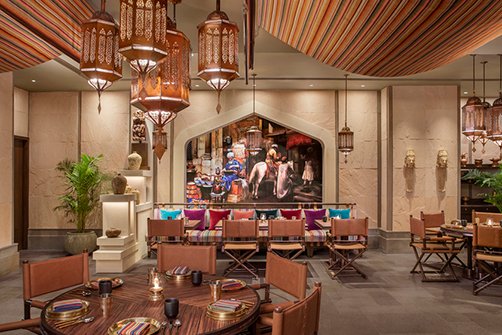Midnight trains packed with spent salarymen. Tangled streets snaking through canyons of neon light. Alleys wall-to-wall with shops hawking bowls of ramen and electronic parts. And of course, the world’s busiest crossing, where pedestrians glued to their cell-phone screens fire like pinballs every time the walk signal turns green.
Images like these have branded Tokyo as a concrete jungle that never sleeps. But if you get to know the city’s vast constellation of neighborhoods, a more nuanced picture comes into view. From trendy Tomigaya to local-favorite Kichijoji, many areas prove that even Tokyo has a quiet side. Here are some of the best spots to experience Tokyo like a local.
A great place to start is Tomigaya.


This stylish inner-city oasis just beyond Shibuya’s thrum is an ideal entry point into Tokyo’s local side. The best way to experience this vibrant community of in-the-know locals and expats is to cafe or bar hop through its calm lanes.

Camelback Sandwich & Espresso is a great spot for a daytime caffeine shot and a bite to-go. Another popular hangout is the Japanese outpost of Norwegian cafe and bar Fuglen, which serves coffee in the daylight hours and aperitifs after dusk. And in the evening, Ahiru Store, the community’s favorite wine bar, serves a great menu of Japanese-inspired Western tapas.
Not too far from Tomigaya, Daikanyama
is a relaxed, sophisticated district perched on a hill between Shibuya to the north, and the upmarket hub of Ebisu to the south. This posh area is home to purveyors of trendy artisan goods, chic eateries and one of the world’s coolest bookstores––all a brief stroll uphill from Ebisu’s buzz.

For an introduction to the area’s shops, swing by Okura. Here you’ll find eye-catching goods made with Japan’s age-old indigo-dyeing technique: T-shirts, jeans, scarves, tabi (split-toed socks) and more. Look for the old-school, squat shopfront with an indigo item on display out front.
After meandering through the surrounding lanes, head to the neighborhood’s beating heart, Daikanyama T-Site. This understated complex, designed by architectural firm Klein Dytham, has snagged design awards. Spread between three wings linked by open-air corridors, the exterior of this vast complex is enveloped in a net of myriad letter Ts. You’ll find books, vinyl, and various cultural accouterments on its shelves. Choose an artsy design or travel mag, then while away a few hours beside dapper locals over a coffee or cocktail at Anjin, the chic lounge upstairs.

For something more intimate, try Mocha Coffee, a glass-walled hideaway nearby that exclusively serves coffee made with beans from Yemen. And if you happen to be in the area at night, check out Debris, a bar and event space that holds club nights, film screenings, art shows, and serves craft cocktails with a carefully curated selection of spirits from around the globe. There’s also an attached restaurant upstairs that serves good Taiwanese fare.
To go deeper, in a slightly more bohemian direction, stroll less than 10 minutes downhill to the district of Nakameguro. Hip cafes, bistros, boutiques and bars line the cherry tree-fringed canal that runs through the area, and dot the bystreets fanning out from Nakameguro Station. By day, head to Onibus Coffee for a single-origin espresso to-go. For dinner, try Mahakala, which serves first-rate kushikatsu (an Osaka-born dish of deep-fried meat and veg on skewers). At night, head to Cabin, a trendy watering hole with a venerable stash of Japanese whisky, or Solfa, a wonderfully intimate nightclub.
Next, we turn our attention to Aoyama,
a bastion of high-end fashion and more high-brow architecture just beyond the masses of Omotesando. After joining the obligatory throngs around Harajuku Station at Meiji Jingu and Yoyogi Park, proceed down the broad avenue of Omotesando until you reach the intersection with Aoyama-dori. When you cross, you’ll emerge into leafy Aoyama.


While Omotesando’s main stretch is mostly occupied by international brands, quieter Aoyama boasts the flagships of Japan’s ‘big three’ names in fashion: Issey Miyake, who exploded onto the global fashion map in the 1980s for his colorful, geometric designs made with experimental materials; Rei Kawakubo, a renegade-chic icon who launched the Comme des Garcons label in the 1980s; and Yohji Yamamoto, known for his black flowing garments made with Japanese tailoring techniques. Also keep your eyes open for the bubble-like Prada shop. This five-sided structure is wrapped in diamond-shaped windows of convex glass.

After ambling down this open-air catwalk, proceed to the tranquil Nezu Museum to catch your breath. Aside from housing a brilliant collection of pre-modern East Asian art and revolving exhibitions of various Japanese crafts (from paintings and lacquerware to textiles), there’s a serene garden for strolling behind the museum, overlooked by a refreshingly uncrowded cafe. The museum complex itself is also a knockout. Designed by celebrity architect Kengo Kuma, it embodies a seamless blend of modern and traditional aesthetics.


If you’ve worked up an appetite, proceed another seven minutes’ walk southeast to Butagumi. This premium tonkatsu joint, tucked away in a quiet residential pocket of Nishi-Azabu, uses only the best pork, sourced from as far away as Spain, served with rice, miso soup and shredded cabbage.
In the geographic center of Tokyo, the fashionable neighborhood of Kagurazaka,
along a slope that runs north of Iidabashi Station on the JR Chuo-Sobu line, oozes a subtle blend of traditional Japanese and old-world European charm. Some consider it Tokyo’s unofficial French quarter. It’s home to a few notable shrines, great restaurants, and sees the occasional geisha flit along its cobblestone paths.

For lunch in the area, try Le Bretagne, an excellent creperie owned by a native of Brittany and set in an atmospheric side street. Once you’ve fueled up, wander the area’s lanes before paying your respects at Akagi Shrine, towards the top of the hill. This religious complex was remodeled in 2010 by (yet again) the feted Kengo Kuma, who melded glass and wood to create it. There’s also a restaurant on site that rustles up good Italian dishes.


By evening, as soft light bathes the backstreets, stylish eateries beckon. One great pick is Tempura Arai, a chic and modern tempura restaurant with a long California wine list. Also in the area is Sake Bar Otonari, a subterranean space with a serious stash of the brew, sourced from around the country and paired with a spread of ham-based items and food made at the izakaya next door.
Shifting gears outside of downtown, Kichijoji is a prime specimen.
About 15 minutes by train west of Shinjuku on the JR Chuo line, and 20 minutes by train from Shibuya on the Keio Inokashira line, it’s far enough from downtown to lower the intensity a few notches, yet retains a nice buzz. These factors keep it hovering around the top of Tokyo’s most coveted places to live.

A rambling district of boutiques and restaurants spreads north of the station with something for everyone. But the focal point of the neighborhood is undoubtedly Inokashira Park, to the south. The sheer amount of tree cover in this lovely green space sets it apart from Tokyo’s other big parks such as those in Ueno or Yoyogi. And on weekends, local artists hawk their handmade wares (jewelry, paintings, photographs, etc.) and performers put on shows. It’s also home to the popular Ghibli Museum, a whimsical ode to anime director Hayao Miyazaki’s creative vision.


At the park’s core, a path wraps around a large central pond, which you can traverse in swan-shaped paddle boats. Just be aware that, according to local legend, resident goddess Benzaiten, who resides in the shrine at the southwest corner of the pond, is said to curse couples who ply the waters, triggering their break up.

The area around the park also has a glut of excellent cafes and eateries, so take your time and enjoy this unique setting. Cafe du Lievre (Bunny House), a charming hideout in the forested depths of the park that serves Japanese curry and crepes (both savory and sweet), is a good lunch pick. For a coffee to sip as you stroll, stop by Blue Sky Coffee, a little cafe on the park’s south side.
In the evening, the best place to join locals for dinner is the warren of culinary alleyways known as Harmonica Yokocho north of Kichijoji Station. Of all the hole-in-the-wall joints in this network of alleys, which brimmed with black-market stalls in the postwar years, the decidedly funky Tetchan is a mainstay. Designed yet again by ‘starchitect’ Kengo Kuma (see Nezu Museum and Akagi Shrine above), this shop serves grilled meat and vegetables on sticks and hearty offal stews. Wash it all down with frosty mugs of beer at the large wraparound bar, lined by stools made from melted-down translucent acrylic. Be sure to take note of the cheeky wall art downstairs, then climb the spiral staircase at the back to behold a second-floor interior plastered in jumbles of recycled LAN cables.

Jonathan DeHart is a Tokyo-based writer and editor focused on culture and society in Asia. He is the author of a first-edition Japan guidebook for Moon Travel Guides and a journalist with more than 500 published articles. www.jonathandehart.com; @tokyo.flaneur


